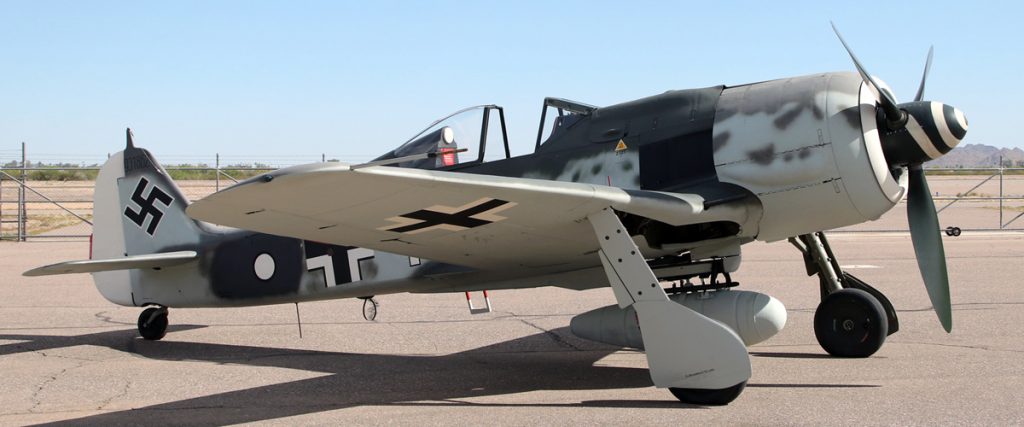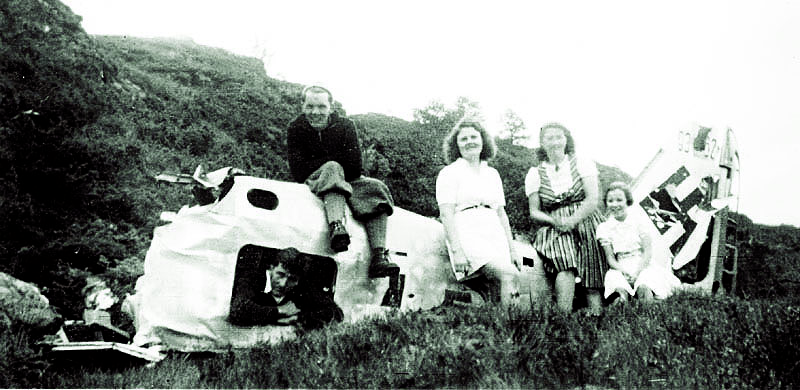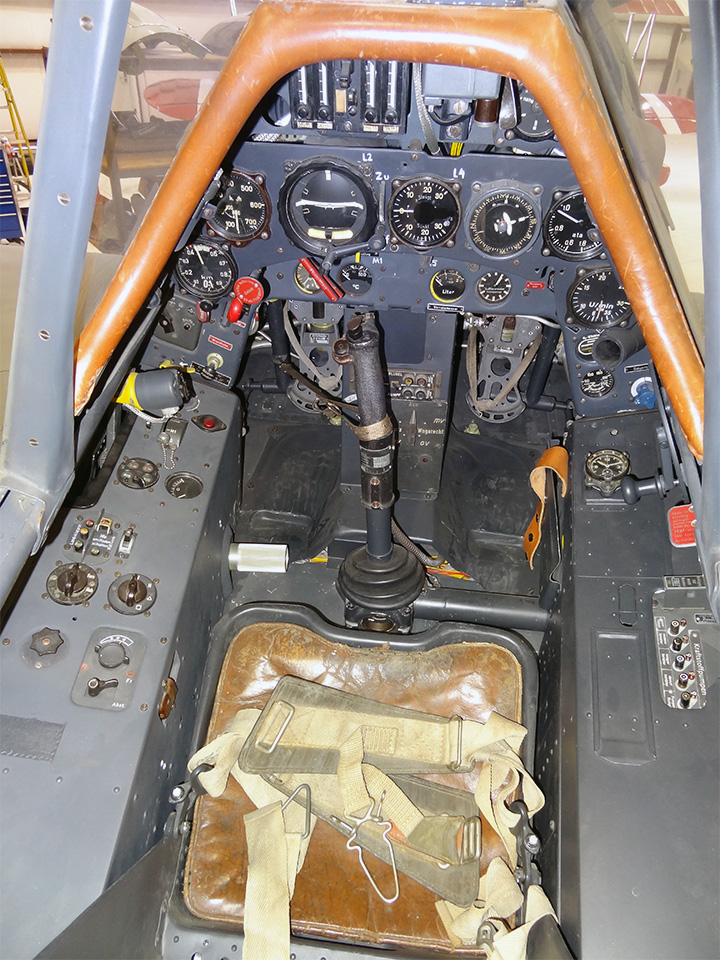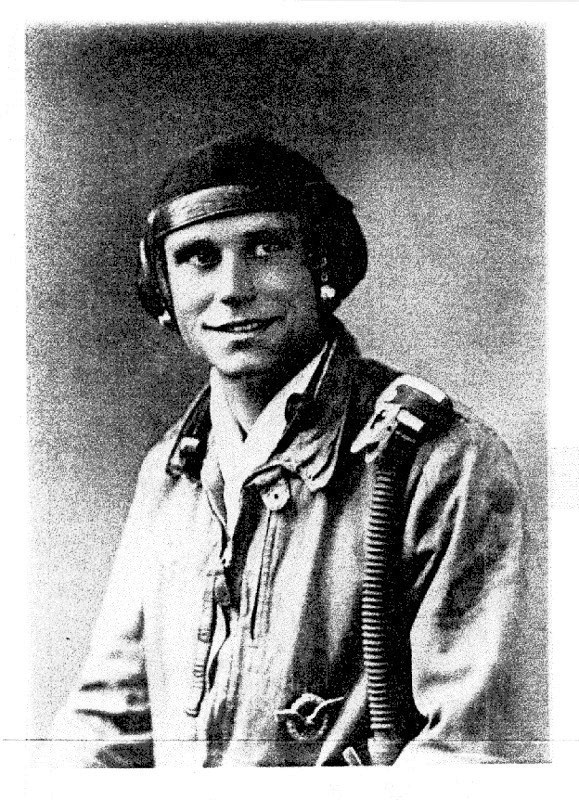Introduced as a terrible surprise to the RAF Spitfire Mk. V at the disastrous 1942 Dieppe Raid in France, the German Fw 190 wrested control of the air from the RAF. It was not until the debut of more advanced fighters such as the Spitfire Mk. IX that there would be any match for this advanced German plane. The Fw 190 proved to be a lethal fighter through WWII, evolving into a powerful “F” model fighter-bomber or “Jabo.” Close air support roles were greatly expanded by the introduction of this extraordinary aircraft.
Serving as a front line fighter, the Fw 190 had heavy armament and speed, with excellent landing gear as well. These advancements offered significant improvement over the notorious German Me 109. Later, its design was further enhanced to challenge
advanced Allied fighters such as the improved P-51 Mustang with the Merlin engine.

It is a rare honor to restore an original fighter that has such a deep and rich history as Fw 190F-8 Wrk. Nr. 931 862. Currently, there is only one fully restored and flying Fw 190 in the world. Flying Heritage Collection in Washington has a Fw 190A-5 that was assigned to JG 54 near Leningrad during WWII. Once Fw 190 Wrk. Nr. 931 862’s restoration is complete in 2020, this will be one of two flying Focke-Wulf 190s in the world.
The Collings Foundation’s Focke Wulf Fw 190F-8 “White 1” (Work Number 931 862) was constructed at Norddeutsche Dornier-Werke in early June 1944. The Luftwaffe immediately threw the aircraft into combat, supporting ground troops of the Wehrmacht that were under heavy pressure from the Russian Red Army. Fw 190 Wrk. Nr. 931 862 was one 6 Fw 190F-8s delivered to Jagdgeschwader 5 (JG 5) squadron in mid-August 1944, together with 13 Fw 190A-8s first stationed at Nautsi in Finland.
Jagdgeschwader 5 (JG 5) was a German Luftwaffe fighter wing that operated in the far north of Europe, primarily Norway, and northern parts of Finland. The unit was responsible for providing fighter-cover over occupied territories under Luftflotte 5, and also fighter support for the German Army units battling on the Arctic front in the Murmansk area.
Focke Wulf Fw 190F-8 (Wrk. Nr. 931 862) saw substantial combat while serving in JG 5 stationed in Norway.
On August 1st, 1944, Heinrich Ehrler was appointed Geschwaderkommodore (squadron commodore) of JG 5. That lasted until he was court martialed and found guilty of cowardice for his perceived inability to protect the colossal battleship Tirpitz from relentless British bomber and fighter attacks (he was later re-instated). In early January 1945, following Ehrler’s conviction by the Reichskriegsgericht, Oberstleutnant (Lieutenant Colonel ) Scholz assumed command of JG 5.
The Tirpitz was the second of two Bismarck-class battleships built for Nazi Germany’s Kriegsmarine (Navy) prior to and during the Second World War. On November 12th, 1944, Avro Lancaster bombers of RAF Squadrons 9 and 617 attacked the Tirpitz for the last time as it sat moored near Håkøy island, three miles west of Tromsø. British forces had attacked the Tirpitz many times prior. On September 22nd, 1943, Operation Source had struck the battleship first using mini submarines. Although charges were successfully detonated
under the Tirpitz, the ship remained upright. Subsequent attacks including Operations Tungsten, Planet, Brawn, Tiger Claw, Mascot, Goodwood and more were all unsuccessful. These missions resulted in many downed British aircraft due to AAA fire from the
Tirpitz and fighter attacks. It wasn’t until Operation Catechism, on November 12th, 1944, that Lancaster bombers with their “Tallboy” bombs were able to finally sink the massive ship with the loss of over a thousand sailors. Fighters from JG 5 were scrambled to intercept the bombers, but it was too late.
Fw 190 “White 1,” piloted by Werner Gayko and Heinz Orlowski, flew many missions with JG 5. On January, 12th, 1945, pilot Werner Gayko flew a special operation, taking “White 1” out of Herdla, Norway to intercept Lancasters, Mosquitos and Mustangs which were
attacking the U-boat pens there. During this mission, Gayko, flying “White 1” earned his 13th victory, shooting down a Lancaster (of 617 Squadron) at high altitude. Orlowski, who was flying Fw 190 “White 11” at the same time, also shot down a Lancaster. “White 1” continued to intercept and shoot down bombers and fighters from its bases on the western coast of Norway. “White 1” was eventually transferred to the small island airbase at Herdla, where it stayed for the rest of the war.
Our Fw 190 “White 1” flew its last mission during the Battle of Førdefjord, known as Black Friday to the British, on February 9th, 1945. Black Friday was one of the largest and fiercest air battles ever fought over Norwegian soil. Due to Allied victories in France and Eastern Europe, Germany’s surface shipping had become confined to the lower Baltic and Norwegian waters by late 1944. “White 1,” piloted by Heinz Orlowski, was to protect the German destroyer Z33 and its support vessels from Allied Bristol Beaufighters and their P-51 escorts. “White 1” was in the first group of 9 Fw-190s attacking the British raiders consisting of 32 Beaufighters and 10 Mustangs. The force of Beaufighter aircraft suffered many losses during the attack. The German ships had sheltered in a strong defensive
position deep in Førde Fjord, Norway, forcing the Allied aircraft to attack through massed anti-aircraft fire. The Allies damaged at least two of the German ships, but lost seven Beaufighters to flak guns. Two Beaufighters and a Mustang were shot down by the Fw 190s. Four or five of the German planes were shot down by Allied aircraft, including one flown by German ace Rudi Linz, who was posthumously awarded the Knight’s Cross of the Iron Cross for achieving 70 aerial victories.
The Beaufighters continued to suffer heavily at the hands of the Focke Wulfs. Near Gaular, Norway, alarmed civilians witnessed a Beaufighter being pursued by “White 1” piloted by Orlowski. The Beaufighter was hit several times and tried to land on a slope, but the terrain made this impossible. The plane broke in half during the crash and the crew perished. (Flight Officers Knight and Lynch.) A single Mustang had come to aid the Beaufighter, attacking “White 1.” A long aerial duel commenced. The Mustang was hit and caught fire. Its pilot made a wide turn out over a fjord. According to eyewitnesses, the pilot must have been badly wounded. But, instead of bailing out he continued to fly his P-51 Mustang toward the attacking Fw 190. The Mustang crashed in a pine forest. P-51 pilot Cecil Claude Caesar died in the crash. It was the only Mustang loss in this battle.
“White 1” remained in peril. Its engine had been severely damaged during the duel, and the pilot Orlowski was forced to bail out. He was too close to the ground for his chute to open fully. Amazingly, Orlowski survived the fall by hitting a cushion of deep snow. A small avalanche carried him to the bottom of the hill. During the journey down, the flare cartridges around his leg caught fire, causing severe burns. Local Norwegians found him in a hay shed and took him to the hospital. Heinz Orlowski survived the ordeal. His crashed Fw 190 “White 1” (Wrk. Nr. 93182) sat lodged into the snowy Norway hillside for more than twenty-five years.
In total, pilots of JG 5 claimed approximately 3,200 aerial victories during World War II. At the end of hostilities, losses had amounted to 435 men either killed in action or taken prisoner of war.

Known only by the locals, the “White 1” wreckage sat in place until salvage began in September 1983. The plane was recovered from it longtime resting spot at the crash site on the mountain of Litlehesten near Forde, north of Bergen, Norway. Although the Aviation branch of the Norwegian Defense Museum was just forming, several affiliated parties thought it important to secure remains of German aircraft still spread across Norway. The West Norwegian Air Historical Group was allowed to search for German fighters and became the driving force behind the initial salvage of “White 1.” Using a
helicopter and truck, the wreckage was taken to Flesland Airport near Bergen. Eventually, the Norwegian Defense Museum decided to pass the restoration project on to the Texas Air Museum in the United States. For many years, Dr. Mark Timken championed the resurrection of this extraordinary aircraft at his home base in Kissimmee, Florida.
Timken sold the project several years ago, and the Collings Foundation took up the challenge, moving the fighter to GossHawk Unlimited in Casa Grande, Arizona. GossHawk has a stellar reputation in aircraft restoration. They are no strangers to the 190 as a breed, having restored the Flying Heritage & Combat Armor Museum’s Fw 190A-5 and the Fw 190D-13 of the Champlin Fighter Collection. After 25 years of work, Fw 190 “White 1” is
now complete.
 This Fw 190F-8 “White 1” has embodied the most exquisite and thorough restoration work ever completed on a WWII aircraft. Attention to detail was extreme. For example, the decision was made to have exact German WWII rivets manufactured rather than utilize standard off-the-shelf rivets. Then, utilizing sources deep within Europe, Fw 190 crash sites were scoured to find small components needed to bring the airframe up to exact WWII combat condition.
This Fw 190F-8 “White 1” has embodied the most exquisite and thorough restoration work ever completed on a WWII aircraft. Attention to detail was extreme. For example, the decision was made to have exact German WWII rivets manufactured rather than utilize standard off-the-shelf rivets. Then, utilizing sources deep within Europe, Fw 190 crash sites were scoured to find small components needed to bring the airframe up to exact WWII combat condition.
 The instrument panel is 100% authentic and has no visible concession to modern airworthiness. The dynamic paint scheme illustrates the subtle camouflage and surface detail that helped “rewrite the book” on restoration of WWII aircraft. A strenuous effort was undertaken to research the original camouflage utilizing modern technology and then have the paint recreated by a German Factory that supplied the Fw 190 paint during the war.
The instrument panel is 100% authentic and has no visible concession to modern airworthiness. The dynamic paint scheme illustrates the subtle camouflage and surface detail that helped “rewrite the book” on restoration of WWII aircraft. A strenuous effort was undertaken to research the original camouflage utilizing modern technology and then have the paint recreated by a German Factory that supplied the Fw 190 paint during the war.
The Fw 190F-8 will be moved to the American Heritage Museum in Stow, Massachusetts and on display along with several other rare WWII fighters sometime in 2023. Continue to check our website for most up to date information and movement of this amazing fighter.










